Nicole C. Engard's Blog, page 5
May 20, 2015
Bookmarks for May 20, 2015
Today I found the following resources and bookmarked them on Delicious.
Coffitivity
Coffitivity recreates the ambient sounds of a cafe to boost your creativity and help you work better.
Digest powered by RSS Digest
The post Bookmarks for May 20, 2015 appeared first on What I Learned Today....
Related posts:
New: The Journal of Library Innovation
Google Buys Feedburner – it’s official
Monitor your sites
May 15, 2015
Bookmarks for May 15, 2015
Today I found the following resources and bookmarked them on Delicious.
Dashboards by Keen IO
Charts on Grids – Responsive Dashboard Templates with Bootstrap
Digest powered by RSS Digest
The post Bookmarks for May 15, 2015 appeared first on What I Learned Today....
Related posts:
ATO2014: Using Bootstrap to create a common UI across products
Speeding up WordPress Dashboard
Google Docs Templates
May 13, 2015
Building Robots in Pasco County Library
 Today I got to attend a talk by Pasco County Library system at the Florida Library Association conference on how they are building robots in the library. They work with a non-profit called First that helps get kids excited in areas of STEM. Pasco is the only public library in the US doing this and has named their team Edgar Allan Ohms.
Today I got to attend a talk by Pasco County Library system at the Florida Library Association conference on how they are building robots in the library. They work with a non-profit called First that helps get kids excited in areas of STEM. Pasco is the only public library in the US doing this and has named their team Edgar Allan Ohms.
It’s important to not be scared of this. You don’t have to be an engineer to participate in this program, it’s about more than robot building. The students build these robots, compete with them and then can apply for scholarships through First. The students run the entire program. They build the website, design the logos and signs, build the robots, etc.
How did Pasco do this? They converted a space in their library to a makerspace with outlets, tools and even non-robotic tools like sewing machines and autoCAD tools. Of course they are trying to do this as cheaply and quickly as possible – this too teaches the kids on how to use ‘found’ items to make these things happen. Another skill they’re teaching the kids is out to sell themselves, how to fund-raise, and how to talk to people to get funding and promotion. It’s so much more than kids just sitting around playing games all day – they are learning real life skills.
How do librarians (with no engineering background) do this? You go out in to your community and find people who want to help out! They are using family members, community members, library fans, and local businesses to help provide tools, supplies and services. People know about First and so everyone wants to help. In some cases people will come to you and offer to help if they hear about what you’re doing. If you can’t find anyone yourself First will help you.
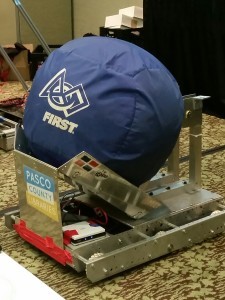 They start each August, and this year there are so many interested that they will be interviewing kids to find those who will commit. They attend workshops weekly and bi-weekly August through December to talk about the rules and plans. In January they go in to competition mode – this is when they start to build the robot. This video shows the rules that the team had to use last year in order to build their robot – this was shown to all teams at the exact same time and from then they spend the next 6 weeks building.
They start each August, and this year there are so many interested that they will be interviewing kids to find those who will commit. They attend workshops weekly and bi-weekly August through December to talk about the rules and plans. In January they go in to competition mode – this is when they start to build the robot. This video shows the rules that the team had to use last year in order to build their robot – this was shown to all teams at the exact same time and from then they spend the next 6 weeks building.
They need to start with some planning based on the rules in the video. The kids will start designing on CAD, testing it in modeling software online, and go from there to building something that will run.
Everything these groups are doing is open and shared. This means that the kids of learning job skills not just in engineering but marketing and writing and others. The groups that will be competing go out on scouting missions where they see what other groups have done and learn from them.
So, if you want to do this in your library how do you get funding and approval from your lawyers? First off explain that you will get some funding from the program itself. Next show that the this program is going to help the community members by offering scholarships to the kids, teaching them real skills and bringing the kids out into the community. Think about it this way – how much does a high school pay for a football team? For a fraction of that you can bring together 25 kids and teach them a skill for life whereas most of those kids who play football in high school don’t end up in the NFL. For the lawyers the library basically said that this is a valuable program and went to bat to get it to go through. In the end the lawyers wrote up a disclaimer that all the kids have to sign in order to participate.
This is the kind of program that more libraries should be offering to encourage kids to learn about STEM and bring library awareness to the entire community – our libraries are about so much more than books and DVDs and this is a great way to show that.
The post Building Robots in Pasco County Library appeared first on What I Learned Today....
Related posts:
Keynote: Licensing Models and Building an Open Source Community
How To Get More Kids To Code
SxSW: Building the Open Source Society
May 11, 2015
Bookmarks for May 11, 2015
Today I found the following resources and bookmarked them on Delicious.
Which Flight Will Get You There Fastest?
FiveThirtyEight analyzed 6 million flights to figure out which airports, airlines and routes are most likely to get you there on time and which ones will leave you waiting.
SemanticScuttle
SemanticScuttle is a social bookmarking tool experimenting with new features like structured tags and collaborative descriptions of tags.
Digest powered by RSS Digest
The post Bookmarks for May 11, 2015 appeared first on What I Learned Today....
Related posts:
Delicious Tag Bundles
A Wiki goes Social
Flight info from Google
April 26, 2015
TCDL: Karma – A Data Integration Tool
Today I got to attend a 1/2 day workshop at the 2015 Texas Conference on Digital Libraries (TCDL) on Karma and open source data integration tool. Pedro Szekely was our instructor and started by warning us that he knows very little about libraries but a ton about data.
The files we needed for the workshop are all in Github if you’re interested in checking it out. You can follow the tutorial steps on the wiki. And of course you can find Karma itself on Github as well.
The Basics
Karma is a web based tool that run both the server and browser right on your own machine so we had computers with the tool installed to play with.
Karma is an open source tool that makes it easy to convert data from a variety of formats into Linked Data.
Users load into Karma the ontologies for their application and data samples of each of the data files to be converted. Karma makes the conversion process easy as it provides an intuitive graphical user interface to visualize and edit the mapping of data files to ontologies; Karma is flexible as it can import data from a wide variety of data formats (SQL, XML, JSON, CSV, Excel, AVRO, Web-Services) … Karma scales to very large dataset (40 million documents, 1 billion triples) and can refresh periodically (e.g., every hour); Karma is a free, open source tool.
Hands On
The rest of the workshop was hands on experience with Karma. We played with some sample data.
After we loaded some data in to Karma we mapped it to a few ontologies. When clicking on the title field for example, Karma even gave us 4 suggestions for what our titles might need to be mapped to, it knew how to make this suggestion because the tool learns (even if you made a mapping mistake in the past). This can be a huge time saver if you’re often working with the same types of data. Pedro did remind us that Karma does not know the right mapping, the user gets to choose whatever they want – even if it’s “wrong”.
Once in your data you can use Python scripts to clean up your data if you’d like. Each column has a ‘PyTransform’ option in the menu. I personally have never written Python, but it looks pretty simple and Pedro assured us that before he used Karma he also didn’t know Python but found that every question he had already had been asked and answered on StackOverflow.
Once you’re done working with your data you can then generate RDF, MySQL, JSON or many other formats for use with web applications.
When we were editing the data in a column Pedro made a very funny comment about one of the options we had to choose from. He said “You should never do that” and when asked by it was an option at all he said “because someone asked us to add it.” This is a question I find myself answering the same exact way when teaching people how to use open source tools. Open source is full of features that are there just because someone asked for it.
Conclusions
What I learned after this workshop is that Karma is awesome powerful! We have so much messy data out there that a tool like this can be very handy – and of course it’s open source which just makes it that much more appealing. I also learned that I’m probably not really cut out for working with a tool like Karma on a daily basis, but I know a lot of people who will be and I hope this summary will help them out.
Links/Resources
TCDL Sample/Tutorial
Karma on Github
Possible Schemas (from our tutorial)
DPLA
SKOS
EDM
Dublin Core
Cool URIs
The post TCDL: Karma – A Data Integration Tool appeared first on What I Learned Today....
Related posts:
Keynote: We The People: Open Source, Open Data
Spam Karma – Solved
KohaCon10: Library Data for Fun & Profit
April 25, 2015
Bookmarks for April 25, 2015
Today I found the following resources and bookmarked them on Delicious.
Libhub
The Libhub Initiative aims to raise the visibility of Libraries on the Web by actively exploring the promise of BIBFRAME and Linked Data.
HexChat
HexChat is an IRC client based on XChat, but unlike XChat it’s completely free for both Windows and Unix-like systems.
XChat Aqua/Azure
XChat Aqua/Azure is an IRC client for OS X based on xchat2.
XChat: Multiplatform Chat Program
XChat is an IRC chat program for both Linux and Windows. It allows you to join multiple IRC channels (chat rooms) at the same time, talk publicly, private one-on-one conversations etc. Even file transfers are possible.
Colloquy
Colloquy is an advanced IRC, SILC & ICB client
LimeChat: IRC Client for Mac
LimeChat is an IRC client for Mac OS X.
Digest powered by RSS Digest
The post Bookmarks for April 25, 2015 appeared first on What I Learned Today....
Related posts:
Evernote for Mac
Launchy for Windows – Like Finder for Mac
Design for Size
April 22, 2015
Bookmarks for April 22, 2015
Today I found the following resources and bookmarked them on Delicious.
?dygraphs.com
An open-source JavaScript charting library for handling huge data sets.
Leaflet
Leaflet is a modern open-source JavaScript library for mobile-friendly interactive maps.
Chart.js
Simple, clean and engaging charts for designers and developers
WordPress LMS Plugin by LearnDash®
LearnDash is taking cutting edge elearning methodology and infusing it into WordPress. More than just a plugin, we provide practical and experience driven guidance for individuals and organizations interested in setting up online courses.
DuckDuckGo
The search engine that doesn’t track you.
Digest powered by RSS Digest
The post Bookmarks for April 22, 2015 appeared first on What I Learned Today....
Related posts:
Bulk WordPress Plugin Installer
WordPress bookshelf plugin
WordPress Automatic Upgrade
April 20, 2015
Bookmarks for April 20, 2015
Today I found the following resources and bookmarked them on Delicious.
IPFire
IPFire was designed with both modularity and a high-level of flexibility in mind. You can easily deploy many variations of it, such as a firewall, a proxy server or a VPN gateway.
Karma: A Data Integration Tool
Karma is an information integration tool that enables users to quickly and easily integrate data from a variety of data sources including databases, spreadsheets, delimited text files, XML, JSON, KML and Web APIs.
Digest powered by RSS Digest
The post Bookmarks for April 20, 2015 appeared first on What I Learned Today....
Related posts:
Google and Data
Just what I was looking for!
Handheld Librarian Online Conference
April 18, 2015
Bookmarks for April 18, 2015
Today I found the following resources and bookmarked them on Delicious.
WASSAIL
WASSAIL is a database-driven, web-based application employing PHP, MySQL, and Javascript/AJAX technologies. It was created to manage question and response data from the Augustana Library’s library instruction sessions, pre- and post-tests from credit-bearing information literacy (IL) courses, and user surveys. It has now expanded beyond its original function and is being used to manage question and response data from a variety of settings. Its most powerful feature is the ability to generate sophisticated customized reports.
Digest powered by RSS Digest
The post Bookmarks for April 18, 2015 appeared first on What I Learned Today....
Related posts:
Sorry
Literacy: The Shift From Reading to Writing
Google Answers – Discontinued
CCSC South Central: Teaching Open Source
Today I had the pleasure of attending a talk by Gina Likins from Red Hat at the 2015 Consortium for Computing Sciences in Colleges (CCSC): South Central conference about teaching open source.
Gina started by asking the audience how many people in the room taught open source already – and no one raised their hands!! That means Gina had to start with the background of what open source is. Gina says open source is a cookie (yum). When you bake a cookie you can share the cookies and the recipe with your friends and family. If one of the people you share with is allergic to nuts and the recipe calls for nuts then that person can alter the recipe to make it so that it doesn’t kill them. There is also the potential for people to take the recipe and improve upon it. Now – of course you can go to the store and buy some cookies – but you don’t really know what’s in them and you can’t replicate them. You can try … but then you get sued for sharing those proprietary cookies.
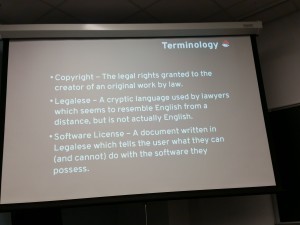 Another open source example – you wouldn’t buy a car with the hood welded shut … so why do we buy proprietary software? If you can’t see what’s going on and see what’s happening under the hood then you’re stuck with the car exactly the way it is and that might not be so great. While some people are fine with that, computer geeks shouldn’t be. We should want to get in there and tinker with it.
Another open source example – you wouldn’t buy a car with the hood welded shut … so why do we buy proprietary software? If you can’t see what’s going on and see what’s happening under the hood then you’re stuck with the car exactly the way it is and that might not be so great. While some people are fine with that, computer geeks shouldn’t be. We should want to get in there and tinker with it.
Next some legal terminology. It’s important to understand copyright. Gina shared with her a pretty flower drawing and now that it’s up there it’s copyrighted (so of course she added a creative commons license to the picture).
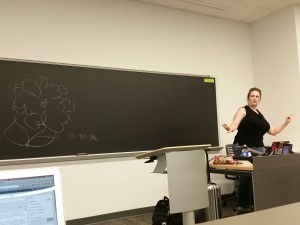 So what’s the difference between open source and free and open source software? The difference is that the free licenses always require that you share what you do under the free license. So if you’re under an open source license and you make a modification you can change the license. If you’re under a free license you don’t have that option – the license must stay the same.
So what’s the difference between open source and free and open source software? The difference is that the free licenses always require that you share what you do under the free license. So if you’re under an open source license and you make a modification you can change the license. If you’re under a free license you don’t have that option – the license must stay the same.
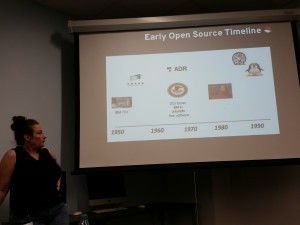 So now – a bit of history because it’s important to know where the magic comes from. In the 50s software and hardware came bundled together. In the 60s that was changed because the DOJ thought that bundling hardware and software was monopolistic. In 1983 Richard Stallman launched the GNU project which were the beginnings of the open source movement as a thing. In 1989 the first GPL was released. This history and intro is the minimum that every computer science graduate should know! Especially the licensing part because students need to know what rights people have to use their software.
So now – a bit of history because it’s important to know where the magic comes from. In the 50s software and hardware came bundled together. In the 60s that was changed because the DOJ thought that bundling hardware and software was monopolistic. In 1983 Richard Stallman launched the GNU project which were the beginnings of the open source movement as a thing. In 1989 the first GPL was released. This history and intro is the minimum that every computer science graduate should know! Especially the licensing part because students need to know what rights people have to use their software.
90% of fortune 500 companies use open source software!! The governments of all 50 states use open source software. 76% of today’s developers use open source. Students need to know about this so that they’re ready when they’re looking for a job. By learning open source you learn to code from others by working in a virtual team and collaborating. By working on an open source project you learn how to learn – because no one is there to sit down and teach you you have to learn a lot yourself – this is how students learn how to problem solve, ask smart questions and read documentation.
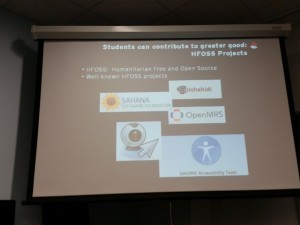 By teaching open source and using open source students get to work on real code, fork that code, and talk about why that was a good/bad idea. As a side note – I personally don’t remember any of the programs I wrote in my computer science classes – none of them had any benefit to me or were saved for me to go back and look at. Students working on open source get to know that they’re working on real code being used by real people. If you’re looking for a project – take a look at Humanitarian Free and Open Source (HFOSS) projects because these attract a more diverse audience – this is a great way to get more women in your classes.
By teaching open source and using open source students get to work on real code, fork that code, and talk about why that was a good/bad idea. As a side note – I personally don’t remember any of the programs I wrote in my computer science classes – none of them had any benefit to me or were saved for me to go back and look at. Students working on open source get to know that they’re working on real code being used by real people. If you’re looking for a project – take a look at Humanitarian Free and Open Source (HFOSS) projects because these attract a more diverse audience – this is a great way to get more women in your classes.
Working on a project is an important skill to teach students because you’re never ever going to work alone in the real world. Furthermore the likelihood that you’ll be writing your own code is very tiny!! Usually you’ll have to add to a project that exists already – and learning how to communicate with other developers is key for this. Working on open source will also allow students to make connections with actual industry connections so that they can use those when it’s time to find a job. It’s a way for student to prove themselves!
Given all that – how do we differentiate open source from proprietary. We already talked about licenses but there are other things to know about. First is the open source principles and second is the community!
The principles includes:
Open exchange: Communication is transparent
Participation: When we are free to collaborate, we create
Rapid prototyping: Can lead to rapid failures, but that leads to better solutions
Meritocracy: The best ideas win
Community: Together, we can do more
All that sounds awesome right? Well, there are some ‘gotchas’.
First off, as academics you’re used to knowing everything about the thing you’re teaching. Open source projects are scary because you’re not going to know them inside and out. There’s an opportunity here though by putting yourself in this role to teach your kids that it’s okay to not know everything and show them how to ask the right questions and learn how to learn. This is how we grow – even if our code isn’t accepted – you grow. Learning that will make it so that students can learn any system.
Next you’ll be a stranger in a strange land. There is no manager or single person in charge – it’s a bit of the wild wild west. This is not an environment you can control – you will be a guest. It won’t be like stepping in to a classroom and saying this is what we’re doing today.
Open source can occasionally be aggressive. With freedom and transparency comes opinions – and sometimes those opinions are not expressed politely. If there were an HR department in open source then some of these things wouldn’t happen – but that’s not how open source works. It’s the Internet – it’s all open and anyone can say anything. The good thing is that instructors are helping students in these situations – hopefully to tell them what is proper etiquette and what isn’t. Hopefully teaching open source in schools will prevent some of this. Learn more about etiquette in open source projects from Gina’s ApacheCon Keynote.
Even with all that it’s extremely important!! Students need to learn what open source is and how to contribute.
Quote from Gina: “It’s amazing how wonderful scary things can be”
How do we move forward? Check out POSSE. Teaches professors what they need to know so they can teach open source in their classes. You can also look at TeachingOpenSource.org and sign up for the mailing list. Finally be sure to look in to OpenHatch which provides tools for building your curriculum and/or learning what open source is like.
The post CCSC South Central: Teaching Open Source appeared first on What I Learned Today....
Related posts:
Teaching Open Source
Teaching Open Source in NJ
Teach Students Open Source



